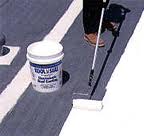This is a guest post by: Erik Braunitzer of Douglas Elliman Real Estate Company, agents for NYC Apartments.
The bathroom is an essential part of most every home. However, the bathroom is also an area that is often neglected when it comes to creating an environmentally friendly and green space. Luckily, when designing or remodeling your home, the nation-wide renewed focus on green living has opened up an entire marketplace full of green items.
And what most homeowners and contractors don’t realize is that going green really boosts the value of your home. Things like geothermal heat, 95% efficient furnaces and walls made with reclaimed materials are just a few examples of expensive but worthwhile home investments. One of my favorite areas of focus is the bathroom.
Recycled Glass Tile: Tile is a commonly used throughout the bathroom, from floors and shower walls to backsplashes and accent work. Consider using recycled glass tiles, which come in a wide range of colors, shapes and sizes. Recycled glass tile is installed in the same manner as regular tile, and can come in pre-spaced squares allowing for easy installation and grouting.
Sustainable Harvested Woods: Wood is often used for vanities and even flooring for bathroom spaces. However, many wood products require the use of environmentally unfriendly or even illegal logging practices to supply the material. Choose products with a Forest Stewardship Council approved sticker on them, or choose more environmentally friendly products like bamboo, cork or wheat straw. Storm-feld tree products are also an option for a greener bathroom. Avoid wood products made from particle board, which often contains formaldehyde.
Recycled Metals: Recycled metals can be used in your bathroom from cabinet pulls to fixtures. Look for products such as recycled metal counter tops, vessel sinks made from recycled metal, recycled aluminum tiles, salvaged brass faucets, and recycled bronze metal hardware.
Composite Terrazzo: Another way to use recycled materials for vanity countertops is through composite terrazzo products. These counter tops are made from a wide range of different materials, such as recycled glass, which is then combined with an epoxy binder or cement to create the hard and formed surface of the countertop. Because there are different types and colors of materials used in each piece, you get a unique finished look to the product you install.
Salvaged Products: Whenever possible, try to use recycled salvaged products in your bathroom remodel. Often times home owners will get rid of light fixtures, cabinets or sinks that are still in style, but that do not fit their own current personal style. Purchasing these products from salvage stores reduces the chances that the product will find its way into a landfill, as well as can provide a unique or vintage look to your bathroom space.
Windows: Install windows in your bathroom to bring in natural light. The more natural light you have flowing into your bathroom, the more open it will feel and the less electricity you will need to use, which reduces your energy waste and brings down your electric bills. Install Energy Star rated windows to help reduce the loss of heat or cold air during the winter or summer months.
Toilet: Toilets make up a significant portion of water usage in most households. Each flush can waste gallons of water, even though newer toilet designs can provide the same performance with less water. Look for toilets made to the HET Standard (or High Efficiency Toilet) which guarantees you’ll be using less water with each flush.
While these steps may seem small, every choice helps create a better world for you, your family and generations to come. By making these simple choices, you can make a positive impact on the environment, all without sacrificing style or function in your bathroom.
Related Posts













